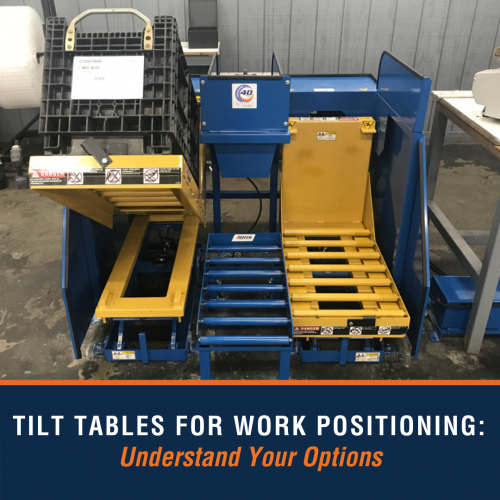We use cookies to make your experience better. To comply with the new e-Privacy directive, we need to ask for your consent to set the cookies. Learn more.
Tilt Tables for Work Positioning: Benchtop Tilters, Lift/Tilters, Upenders, and More

Ergonomic devices fit the work to the worker, reducing the number and severity of musculoskeletal disorders (MSDs) while improving productivity. Per 2013 data from the Bureau of Labor Statistics, MSD cases accounted for 33 percent of all worker injuries and illnesses; applying ergonomic principles can prevent physical overexertion and reduce risks.
Tilt tables keep work positioned properly, significantly improving throughput while keeping employees from making awkward movements, so they’re extraordinarily helpful when building an ergonomic workflow. Of course, for optimal benefit, tilt tables need to be appropriate for the task at hand.
Several options can address the vast majority of needs, but managers should understand the advantages and applications of each type of lift:
- Benchtop Tilters - Benchtop tilters attach to workstations and hold loads at a set angle. While they’re adjustable, they’re primarily designed for applications in which the tilt angle remains constant. Typically, benchtop tilters are used with lighter loads. Standard tilt tables may provide better work positioning depending on the exact nature of the task. Some benchtop tilters can be mounted to stationary lift tables to keep loads at the ideal angle and elevation.
- Mobile Tilt Tables - BHS Manual Mobile Lift & Tilt Tables (MMLTT) have several advantages over benchtop tilters: They’re mobile, they can elevate loads, and the user can change the tilt angle easily, positioning loads at up to 45 degrees. Their hydraulic lift cylinders are controlled via a simple foot pedal, allowing for easy and precise positioning. Optional fork pockets can improve the unit’s mobility, while locking caster brakes keep the table in place during use. The MMLT features durable steel construction and can lift bulk containers easily. However, operations looking for heavy-duty lifts should consider ground-level lift tables and upenders.
- Ground-Level Lift/Tilters - The advantage of a Ground-Level Tilt Table (GTT) is its load capacity. Available with two platform sizes (36" X 48" or 48" X 48") and three capacities (2,000, 4,000, or 6,000 pounds), the GTT tilts up to 45 degrees, providing ideal functionality for product assembly, machine feeding, order packing, and other essential tasks. A floor foot switch activates the self-contained hydraulic power unit for precise positioning. While the GTT can handle a variety of positioning tasks, operations that handle large containers of small, loose materials may prefer the Gaylord Tilter (GLT), which can position loads of up to 2,000 or 4,000 pounds depending on the model. Custom options are also available for both the GTT and GLT.
- Upenders - For heavy industrial applications, the BHS Upender (UPD) combines a compact footprint with a 4,000-lb. lifting capacity. Upenders offer 90-degree work positioning, perfectly suited to palletizing, engine block manufacturing, die, coil, and mold handling, and other tasks that require precise positioning of large, unwieldy objects. As with all BHS material handling equipment, the UPD features steel construction.
- Integrated Tilt Tables - Material handling integration is the process of combining multiple machines into a custom solution for a single task — and Tilt Tables are a common element of these designs. In 2019, the material handling integration team at BHS incorporated a pair of specialized Tilt Tables into a cutaway steel desk and a steel material chute to create an Assembly Work Station for Connector Manufacturing, a major producer of utility and OEM components. The Assembly Work Station protects workers by preventing bending and reaching, and it improves efficiency by creating a steady replenishment system, eliminating trips back and forth to bulk bins elsewhere in the facility.
- Custom Tilt Tables - Heavy manufacturing lines often struggle to position materials for optimal ergonomics and efficiency. Tilt Tables can often solve these problems — but only if they’re built for the purpose. In 2020, BHS designed and constructed a set of custom, 20-foot-long Tilt Tables for top truck body manufacturer Knapheide. These unique, heavy-duty Tilt Tables now stand on Knapheide’s production line, where they allow workers to weld and rivet truck bodies without crouching, bending, or reaching.
When choosing between these options, consider the tasks at hand and look for opportunities to improve throughput through better positioning. Manufacturers may prefer upenders for their 90-degree positioning, while workers on assembly lines might use mobile tilt tables to unpack containers quickly. Welders might use ground-level tilters — or they may prefer the MMLTT for handling smaller loads that need to be moved regularly. And workers who stay at a set location might prefer a stationary Scissor Lift Table equipped with a benchtop tilter.
All lifting & tilting equipment should be evaluated carefully prior to use. Look for products with hydraulic lift cylinders, which are typically more reliable than pneumatic devices. Other factors to consider include country of origin, proprietary components, customization options, and, of course, materials — remember, tilt tables handle heavy loads frequently, so heavy-duty steel construction offers a better return on investment (and more reliable throughput).
The ergonomics revolution has changed the way that workers in all sectors handle day-to-day tasks. Tilt tables make work positioning easier and more intuitive, and when matched to the job, they integrate easily into your workflow while keeping workers safe and productive.
